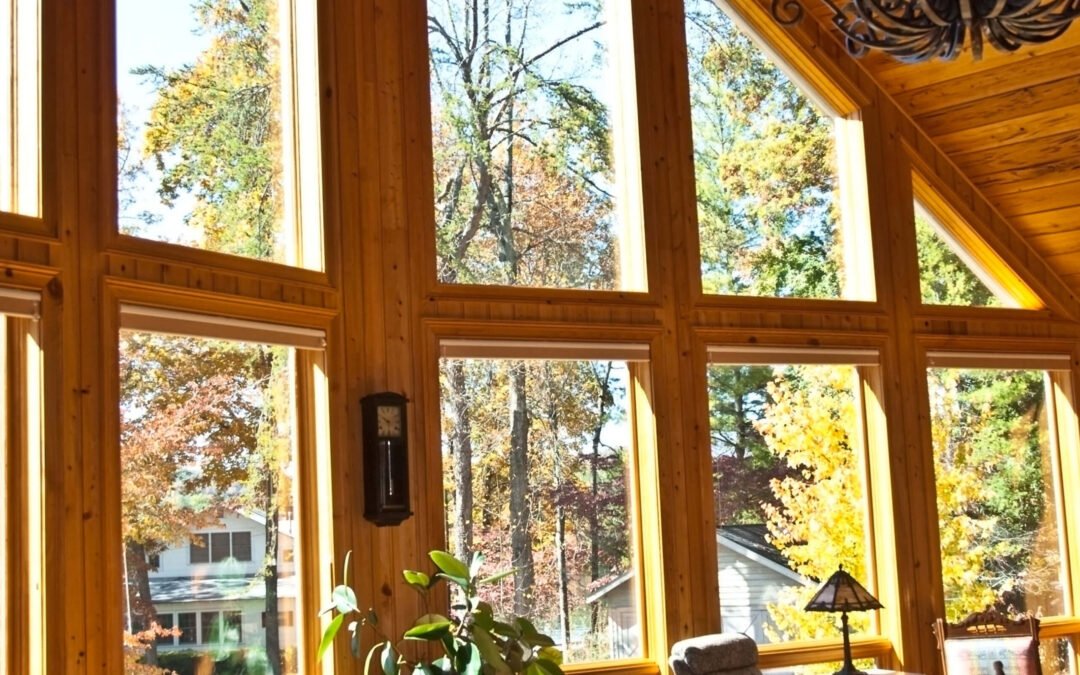When it comes to windows, the material you choose can make a big difference in your home’s appearance, energy efficiency, and maintenance requirements. UPVC, aluminium, and wood are three of the most popular choices, each offering unique advantages that cater to different aesthetic preferences and functional needs. This guide will walk you through the key factors to consider for each material, their benefits, and how to make an informed choice for your home.
Key Factors to Consider When Choosing Window Materials
The right window material can elevate the look of your home while also contributing to its efficiency and longevity. Here are the main factors to consider when choosing new windows for your property.
Aesthetic Appeal
Each material has a distinctive appearance that suits different architectural styles. UPVC, for instance, offers a versatile look with clean lines, making it a popular choice for modern homes. Aluminium has a sleek, minimalist aesthetic that’s perfect for contemporary designs, while wood offers a timeless, natural look that pairs beautifully with traditional or heritage properties.
Energy Efficiency
Windows play a significant role in home insulation, and the material you choose can impact your energy costs. UPVC and wood are naturally insulating materials that help maintain indoor temperatures, while aluminium requires thermal breaks or insulated frames to achieve similar energy-saving benefits. Choosing a material with good thermal performance can lower energy bills and improve indoor comfort year-round.
Maintenance Requirements
Some materials require more upkeep than others. UPVC, for instance, is low-maintenance and only needs occasional cleaning to stay in good shape. Aluminium also requires minimal maintenance but may benefit from occasional cleaning to prevent oxidation. Wood, however, needs more attention to prevent issues like rot or warping, especially in humid or rainy climates.
Durability and Longevity
The lifespan of your windows depends largely on the material you select. Aluminium is extremely durable and weather-resistant, making it an ideal choice for long-lasting windows. UPVC is also resilient, resistant to rust and rot, and performs well over time. Wood, while beautiful and sturdy, requires regular maintenance to ensure longevity, especially when exposed to the elements.
Overview of Window Materials: UPVC, Aluminium, and Wood
Let’s take a closer look at each of these popular window materials, including their characteristics and ideal applications.
UPVC Windows
UPVC, or unplasticised polyvinyl chloride, is known for its affordability, durability, and low maintenance needs. It’s a popular choice for modern homes due to its clean look, and it’s available in various colours, including wood-grain finishes for those who prefer a natural aesthetic. UPVC windows are energy-efficient due to their low thermal conductivity, making them ideal for insulating your home.
Aluminium Windows
Aluminium windows have a sleek, modern look that suits contemporary and minimalist designs. The material’s strength allows for slim frames, supporting larger panes of glass and providing unobstructed views. Aluminium is also highly durable and weather-resistant, especially when treated with a powder-coated finish to prevent corrosion. It’s ideal for homes in extreme climates, as it won’t warp, rust, or degrade over time.
Wooden Windows
Wood offers a timeless, natural beauty that enhances the character of traditional or heritage homes. Wooden windows are highly customisable and can be painted or stained to suit various styles. They provide excellent insulation, helping to keep indoor temperatures stable, but they do require regular maintenance to prevent issues like rot and warping. When properly cared for, wood windows can last for decades, adding warmth and charm to any home.
Key Benefits of Each Material Type
Each window material has its benefits, and understanding these can help you decide which is best choice for your new windows.
UPVC Benefits
- Affordability – UPVC is one of the most cost-effective window materials on the market, offering great value without sacrificing quality.
- Energy Efficiency – UPVC windows have excellent thermal insulation properties, helping to keep homes warm in winter and cool in summer.
- Low Maintenance – UPVC windows are incredibly easy to care for. They don’t require painting or sealing, just occasional cleaning with soap and water.
- Durability – UPVC is resistant to rust, rot, and corrosion, making it ideal for long-lasting, low-maintenance windows in any climate.
Aluminium Benefits
- Modern Aesthetic – Aluminium’s sleek, slim frames offer a contemporary look that’s ideal for modern architecture.
- Strength and Durability – Aluminium’s strength allows for slim frames that can hold large glass panes, maximising natural light and views.
- Weather Resistance – Aluminium is highly resistant to weather, especially with a powder-coated finish, which prevents corrosion and increases its lifespan.
- Minimal Maintenance – Aluminium windows require little upkeep, making them a hassle-free option for busy homeowners.
Wood Benefits
- Classic Appeal: Wood’s natural beauty gives it a timeless appeal, making it the preferred choice for traditional and historic homes.
- Excellent Insulation: Wood is a great natural insulator, helping to maintain comfortable indoor temperatures and potentially lowering energy bills.
- Customisable Finish: Wooden windows can be painted or stained in a variety of colours, allowing homeowners to match their aesthetic preferences.
- Sustainable and Eco-Friendly: When sourced responsibly, wood is a renewable resource, making it an environmentally friendly option for homeowners looking to reduce their carbon footprint.
Cost Considerations for UPVC, Aluminium, and Wood Windows
When choosing window materials, cost is a significant factor that can influence your decision. Each material—UPVC, aluminium, and wood—comes with its own price range and long-term value considerations, so understanding these costs can help you make an informed choice.
UPVC Windows Cost Considerations
Upfront Cost: UPVC is generally the most affordable window material, making it a popular choice for budget-conscious homeowners. Its low production costs and widespread availability contribute to its competitive price, making it an accessible option for most homeowners.
Installation Costs: Installation for UPVC windows is typically straightforward, which can help keep labor costs low. However, costs may vary depending on the complexity of the installation or if you’re replacing non-standard window shapes.
Long-Term Value: UPVC windows are known for their durability and minimal maintenance needs, adding long-term value without significant upkeep costs. Due to their resistantancn to warping, rust, and rot, and good insulation properties, they help reduce energy bills. Over time, the energy savings provided by UPVC can offset the initial investment.
Aluminium Windows Cost Considerations
Upfront Cost: Aluminium windows tend to be more expensive than UPVC but are often cheaper than high-quality wood windows. Aluminium’s higher price is due to its strength, durability, and sleek modern appeal, as well as the manufacturing processes involved in creating high-quality, thermally-efficient frames.
Installation Costs: Installation for aluminium windows may cost slightly more than UPVC due to the material’s weight and the precision required for proper thermal breaks. Labour costs may also vary if large or customised aluminium windows are being installed, as they require careful handling.
Long-Term Value: Aluminium windows offer exceptional durability and are resistant to rust, corrosion, and weather damage. Although their initial cost is higher than UPVC, aluminium windows have a long lifespan and require minimal maintenance. With proper thermal breaks, they also offer decent energy efficiency, which can help with long-term energy savings. Their modern aesthetic and longevity make them a valuable choice for homeowners focused on durability and style.
Wood Windows Cost Considerations
Upfront Cost: Wood windows are generally the most expensive option, especially when crafted from high-quality hardwoods. The cost reflects the natural beauty and craftsmanship involved in wood production, as well as the material’s inherent insulation properties.
Installation Costs: Wood windows are often heavier and require more careful handling and precise installation, which can increase labor costs. Custom finishes, specialised fittings, or unique wood types can also add to the cost. In some cases, wood windows may require custom installation to achieve the best results, particularly in older or heritage homes where they’re commonly used.
Long-Term Value: While wood windows have a higher initial cost, they offer exceptional aesthetic value and insulation properties. However, wood windows require regular maintenance to prevent rot, warping, and pest damage. Repainting, sealing, or staining is typically necessary every few years, adding to the long-term costs. Despite this, well-maintained wood windows can last for decades and add significant character and charm to a home, which can positively impact property value.
| Window Material | Upfront Cost | Installation Cost | Maintenance Cost | Long-Term Value |
| UPVC | Low | Low | Minimal | High due to energy efficiency and low maintenance |
| Aluminium | Moderate | Moderate to high | Low | High due to durability and minimal upkeep |
| Wood | High | High | High (requires regular maintenance) | High aesthetic and insulation value but requires upkeep |
Energy Efficiency Considerations
Energy efficiency is a crucial factor for any homeowner, as it affects both indoor comfort and utility costs. Here’s how each material measures up in terms of energy-saving potential.
UPVC – Due to its low thermal conductivity, UPVC is a naturally insulating material that helps keep indoor temperatures stable. UPVC windows are often double-glazed to enhance energy efficiency, making them a smart choice for eco-conscious homeowners.
Aluminium – Aluminium is a conductor, so it doesn’t provide the same natural insulation as UPVC or wood. However, modern aluminium windows are often fitted with thermal breaks or insulated frames to reduce heat transfer and improve efficiency. When paired with double or triple glazing, aluminium windows can offer competitive energy performance.
Wood – Wood is a natural insulator, making it an excellent choice for energy efficiency. Wooden frames prevent heat from escaping and help keep homes warm in winter and cool in summer. Paired with double-glazing, wood windows are an effective option for minimising energy loss.
Additionally, all three materials can benefit from features like low-E (low-emissivity) coatings and double-glazing, which further enhance their energy efficiency. These options reflect heat back into the room in winter and prevent excess heat from entering during summer.
Maintenance Tips for Each Material
To keep your windows in top condition, it’s important to follow the appropriate maintenance routine for each material.
UPVC Window Maintenance
UPVC windows require minimal maintenance. Simply clean the frames with mild soap and water every few months to remove dirt and grime. Avoid harsh chemicals, which can damage the material.
Aluminium Window Maintenance
Aluminium windows are also low-maintenance, but occasional cleaning with mild detergent will help maintain their appearance. To prevent oxidation, check for any buildup of dirt or grime, especially around the frame edges.
Wood Window Maintenance
Wood windows require more attention than UPVC or aluminium. Regular sealing or painting is necessary to protect the wood from moisture, which can cause rot or warping. If you live in a humid or rainy climate, consider applying a weather-resistant sealant annually.
Conclusion and Final Tips
Choosing the right window material can make a substantial difference in the look, feel, and efficiency of your home. UPVC offers affordability and low maintenance, aluminium provides a sleek, modern aesthetic with strength and durability, and wood brings timeless beauty with excellent insulation properties. By carefully considering your priorities, whether it’s energy efficiency, ease of upkeep, or a specific aesthetic, you can select the best windows to enhance your home’s comfort and style.
For personalised advice and to explore a wide selection of UPVC, aluminium, and wood windows contact our experts. We’re here to help you find the perfect windows that meet both your design vision and functional needs.

